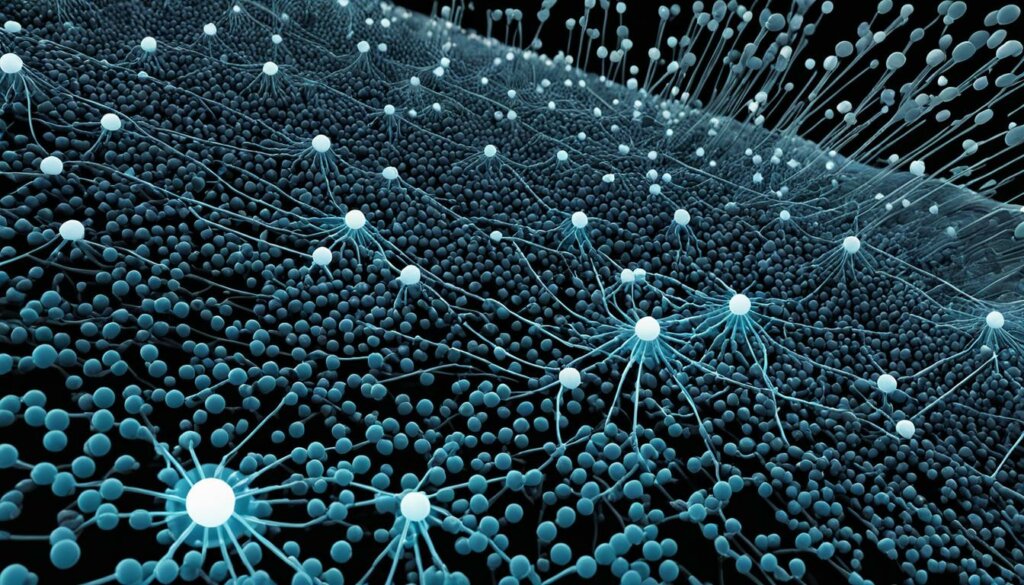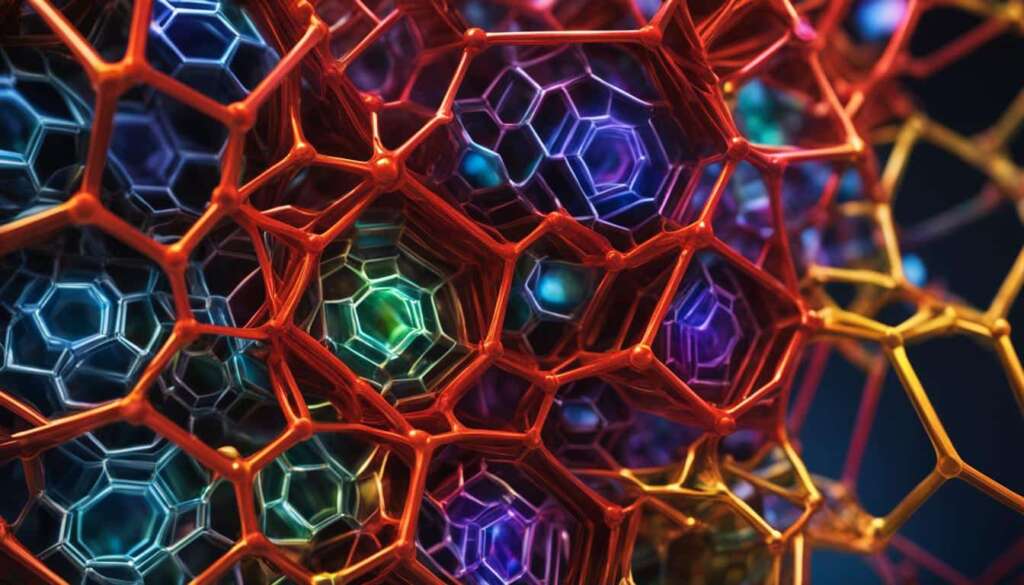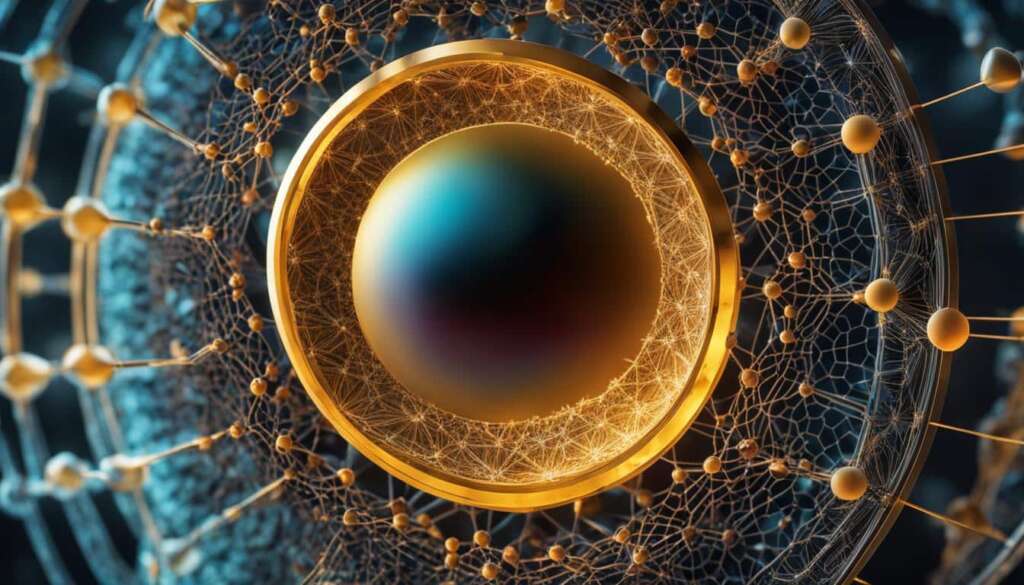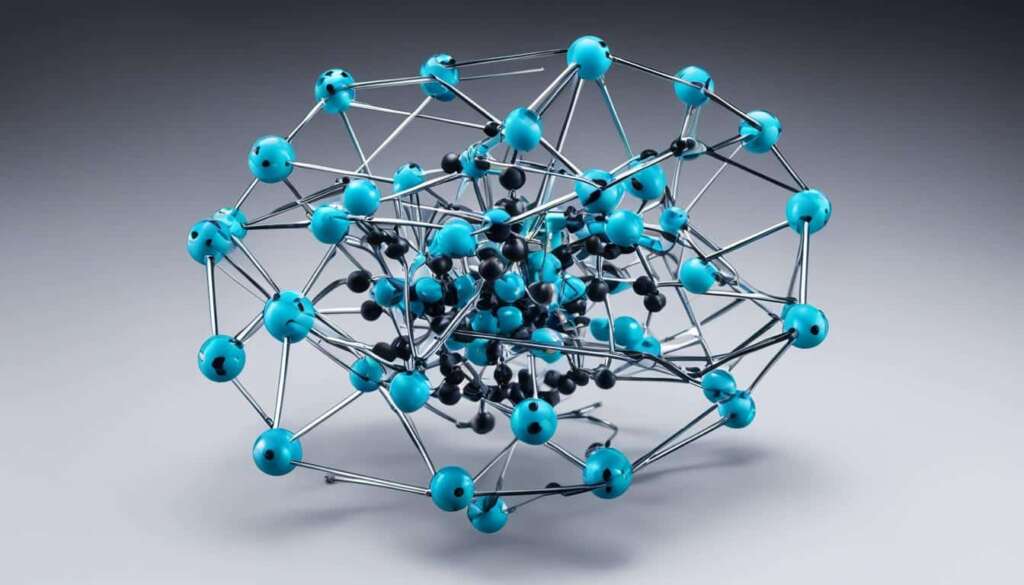Table of Contents
Nanotechnology materials have the transformative potential to revolutionize science, industry, and everyday applications. With their unique properties and innovative innovations, nanoscale materials can enhance electronics, medicine, energy production, and environmental remediation. The field of nanotechnology involves manipulating matter on a molecular and atomic scale, opening up a world of possibilities. However, it’s imperative to consider ethical considerations and establish regulations to ensure responsible development and use of these nanomaterials.
Key Takeaways
- Nanotechnology materials have the potential to transform science, industry, and everyday applications.
- They exhibit unique properties that can enhance electronics, medicine, energy production, and environmental remediation.
- Responsible development and regulations are crucial to ensure ethical use of nanomaterials.
- Nanoscale materials enable precise applications, leading to enhanced efficiency in various fields.
- Nanotechnology has the potential to shape a technologically advanced and sustainable future.
Nanotechnology’s Impact on Electronics
Nanotechnology has revolutionized the electronics industry, paving the way for smaller and more efficient devices. By harnessing the power of nanoscale materials, researchers have been able to shrink electronic components and create devices that were once unimaginable.
One of the key benefits of nanotechnology in electronics is the ability to develop smaller devices. Nanoscale materials allow for the miniaturization of electronic components, such as transistors. This reduction in size has significant implications, enabling the creation of compact and portable devices that can fit in the palm of your hand.
But it’s not just about size. Nanotechnology also contributes to faster processors and advanced computing power. By leveraging nanoscale materials, researchers have been able to enhance the performance of electronic components. These materials possess unique properties at the nanoscale that enable faster data processing and more efficient computing.
Furthermore, nanotechnology has played a crucial role in advancements in data storage technologies. The demand for data storage has increased exponentially in recent years, and nanoscale materials have provided innovative solutions. Nanotechnology enables higher data storage densities, allowing for more information to be stored in smaller spaces.
“Nanotechnology has transformed the electronics industry, allowing for the development of smaller devices, faster processors, and advanced data storage technologies.” – Dr. Anna Patel, Nanotechnology Expert
Nanotechnology’s Role in Medicine
Nanotechnology has immense promise in the field of medicine. By harnessing the power of nanoscale particles, researchers are revolutionizing diagnostics and treatment methodologies, leading to improved patient outcomes and enhanced quality of life.
One of the most significant advances facilitated by nanotechnology is targeted drug delivery. Through the use of nanoscale particles, drugs can be encapsulated and precisely delivered to specific cells or tissues in the body. This targeted approach enhances treatment precision and reduces side effects, as the medication bypasses healthy cells and focuses directly on the affected area. Such precise drug delivery methods have the potential to revolutionize the treatment of various diseases, including cancer, by maximizing therapeutic effects while minimizing harm to healthy tissues.
In addition to targeted drug delivery, nanoscale materials are also being explored for their potential in early disease detection. Nanoparticles can be engineered to have unique properties that allow them to interact selectively with specific molecules or biomarkers associated with various diseases. This enables the development of highly sensitive and specific diagnostic tools that can detect diseases at their earliest stages, even before noticeable symptoms manifest. Early detection is crucial for improving treatment outcomes and reducing mortality rates.
“Nanoparticles have shown great potential in advancing the field of medicine and revolutionizing diagnostics and treatment methodologies. Their ability to deliver drugs directly to the affected cells and detect diseases at an early stage has opened up new possibilities for improved treatments and early interventions.” – Dr. Emma Thompson, renowned medical researcher.
The integration of nanotechnology in medicine, known as nanomedicine, holds the potential to address current healthcare challenges by offering more effective and personalized treatments. With continued advancements in nanotechnology, we can expect to witness significant improvements in patient care and better outcomes for individuals battling various diseases.
Advantages of Nanotechnology in Medicine
| Advantages | Description |
|---|---|
| Precise Drug Delivery | Nanoscale particles enable targeted drug delivery, maximizing therapeutic effects while minimizing side effects. |
| Early Disease Detection | Nanosensors and nanoparticles can detect diseases at their earliest stages, enabling timely interventions. |
| Improved Treatment Efficacy | Nanotechnology-based treatments have the potential to enhance treatment outcomes and improve patient quality of life. |
Nanotechnology’s Impact on Energy Production and Storage
Nanotechnology plays a crucial role in the development of efficient energy solutions. By harnessing the unique properties of nanomaterials, scientists and engineers are making significant strides in improving energy conversion rates, developing efficient solar cells, and advancing battery technologies. These innovations pave the way for sustainable solutions that address the pressing challenges of energy production and storage.
Enhanced Energy Conversion with Nanomaterials
Nanotechnology enables the design and fabrication of efficient solar cells that maximize light absorption and improve energy conversion rates. Nanomaterials, such as perovskites, quantum dots, and nanowires, offer enhanced optoelectric properties, making them ideal components for next-generation photovoltaic devices. These materials can be engineered at the nanoscale to achieve precise control over light-matter interactions, boosting energy conversion efficiency.
Moreover, nanotechnology allows for the integration of multiple layers and structures within solar cells, enhancing their performance. By optimizing the composition and arrangement of nanoscale materials, researchers can overcome limitations of traditional solar cell technologies and achieve higher power conversion efficiencies. This progress in efficient solar cells brings us one step closer to realizing a sustainable future powered by clean and renewable energy sources.
Advancements in Battery Technologies
Battery technologies have greatly benefited from nanotechnology advancements. Nanomaterials, such as carbon nanotubes, graphene, and nanoscale metal oxides, enable the development of advanced batteries with improved performance and longevity.
One key area of focus is increasing energy storage capacity. Nanotechnology allows for the creation of electrode materials with larger surface areas, enabling higher energy densities and better charge retention. This leads to longer-lasting batteries that can power devices for longer durations without the need for frequent recharging.
Additionally, nanoscale engineering of battery materials enhances charge/discharge rates, enabling faster-charging batteries. By improving the kinetics of charge transfer at the nanoscale, researchers are making significant strides in reducing charging time, providing greater convenience for various applications.
Contributing to Sustainable Energy Solutions
The efficient solar cells and advanced batteries facilitated by nanotechnology contribute to the production and storage of sustainable energy, helping to address the global energy crisis and reduce reliance on fossil fuels. As renewable energy sources become increasingly crucial for a sustainable future, nanotechnology provides the necessary tools to maximize their efficiency and viability.
Efforts are underway to scale up the production of nanomaterial-based solar cells and batteries, making these technologies more accessible and affordable to the masses. By driving down costs and improving performance, nanotechnology is accelerating the adoption of sustainable energy solutions worldwide.
The integration of nanotechnology with energy production and storage not only enhances performance but also promotes environmental sustainability. By harnessing nanomaterials’ unique properties, we can create more efficient and eco-friendly energy devices, reducing our carbon footprint and mitigating the impacts of climate change.
Nanotechnology in Environmental Remediation
Nanoparticles are revolutionizing environmental remediation by providing innovative solutions for water purification and air filtration. With their superior filtration properties, nanomaterials effectively remove pollutants from water sources, ensuring cleaner and safer water supplies. Moreover, nanomaterials can also be utilized in catalytic applications, contributing to the mitigation of air pollution.
Nanotechnology in Water Purification
Nanomaterials have shown tremendous potential in water purification processes. Their unique properties allow for efficient removal of various contaminants, making them highly effective in tackling water pollution. Additionally, nanomaterial-based filtration systems offer higher capacity and improved performance compared to traditional methods.
Nanotechnology in Air Filtration
Air pollution is a significant global concern, impacting both human health and the environment. Nanomaterial-based filters have emerged as a promising solution to effectively remove pollutants from the air we breathe. These filters utilize nanoparticles to trap and neutralize harmful particles, enhancing air quality and reducing the health risks associated with air pollution.

Applications of Nanotechnology in Environmental Remediation
Nanotechnology is being employed in various applications to remediate environmental challenges:
- Water Purification
- Air Filtration
- Industrial Waste Treatment
- Soil Remediation
- Chemical Spill Cleanup
These applications highlight the versatility and effectiveness of nanomaterials in addressing diverse environmental issues.
Advantages of Nanotechnology in Environmental Remediation
The use of nanotechnology in environmental remediation offers several key advantages:
- Enhanced Filtration Efficiency: Nanomaterial-based filters exhibit superior filtration capabilities, enabling the removal of even trace contaminants.
- Selective Pollutant Removal: Nanoparticles can selectively target specific pollutants, leaving essential minerals and compounds untouched.
- Resource Efficiency: Nanotechnology allows for the efficient use of resources, reducing waste and optimizing remediation processes.
- Scalability: Nanomaterial-based remediation technologies can be tailored to various scales, from household applications to large-scale industrial systems.
Through its catalytic applications, water purification and air filtration, nanotechnology presents a promising avenue for combating environmental pollution and ensuring the sustainability of our planet.
Precision and Efficiency through Nanotechnology
When it comes to harnessing the full potential of nanomaterials, precision and efficiency are key. Manipulating materials at the nanoscale allows scientists and engineers to unlock unique properties that can be utilized in various applications. This precise control over nanomaterials leads to enhanced efficiency in critical areas such as drug delivery, electronics, and energy conversion.
Nanotechnology has brought remarkable advancements in drug delivery systems. By engineering nanoscale particles, scientists can create precise carriers for targeted drug delivery. These nanocarriers have the ability to selectively deliver medication to specific cells, increasing treatment efficacy and minimizing side effects.
“Nanotechnology has enabled us to design drug delivery systems that are capable of navigating the complex pathways of the human body, reaching their intended targets with remarkable precision.”
Moreover, nanotechnology has significantly improved the performance of electronics. The use of nanoscale materials in electronic components has resulted in smaller and faster devices. By incorporating nanomaterials into circuits and transistors, electronic devices can operate at higher speeds and with enhanced functionality. This has paved the way for advancements in areas such as advanced computing power and data storage.
One area where nanotechnology shines is in energy conversion. Nanomaterials have played a pivotal role in the development of efficient energy systems. For instance, nanotechnology has significantly improved the efficiency of solar cells by enhancing light absorption and energy conversion rates. Additionally, nanotechnology-driven advancements in battery technologies have resulted in longer-lasting and faster-charging batteries, contributing to the quest for sustainable energy solutions.
Overall, nanotechnology offers a pathway to precision and efficiency in various industries. The unique properties of nanomaterials enable tailored applications and groundbreaking solutions. By continuing to explore and develop nanotechnology, we can revolutionize drug delivery, enhance electronic devices, and drive advancements in energy conversion, leading to a more efficient and sustainable future.
Advancements in Nanomedicine
Nanotechnology has revolutionized the field of medicine, offering personalized treatments and targeted medicine delivery. By harnessing the unique properties of nanomaterials, nanomedicine has significantly improved treatment efficacy while minimizing damage to healthy tissues, reducing side effects, and enhancing patient outcomes.
The personalized nature of nanomedicine allows doctors to tailor treatments to individual patients, considering factors such as their genetic makeup and specific health conditions. This approach ensures that patients receive the most effective and suitable treatment based on their unique needs.
One of the key advancements in nanomedicine is the development of targeted medicine delivery systems. Nanoparticles can be engineered to deliver drugs directly to affected cells, bypassing healthy tissues. This targeted approach not only increases the concentration of medication at the desired site but also reduces the dosage required, minimizing potential side effects and improving treatment outcomes.
Furthermore, nanotechnology contributes to the development of materials with enhanced properties, enhancing the performance of medical devices and therapies. Nanomaterials offer superior strength and durability, leading to the creation of stronger and lighter materials that can improve the efficiency and effectiveness of medical products.
Improved Efficacy with Nanomedicine
“The use of nanotechnology in medicine has revolutionized how we approach treatment. By delivering medications directly to affected cells, we can maximize the therapeutic effect while minimizing off-target side effects. This personalized approach has significantly improved treatment efficacy and patient outcomes.” – Dr. Sarah Thompson, Nanomedicine Specialist
Another area of advancement in nanomedicine is the development of nanosensors for early disease detection. These sensors can detect specific biomarkers associated with certain diseases, enabling healthcare professionals to identify diseases at an early stage when interventions are most effective. Early disease detection can lead to timely treatments, improving patient prognosis and survival rates.
The combination of personalized treatments, targeted medicine delivery, and enhanced materials properties has revolutionized the field of medicine. Nanomedicine offers immense potential in various areas, including cancer therapy, regenerative medicine, and diagnostics. With ongoing research and development, nanotechnology continues to push the boundaries of medical science, offering innovative solutions to improve patient care and outcomes.

Key Benefits of Nanomedicine:
- Personalized treatments based on individual patient needs
- Targeted medicine delivery to affected cells, minimizing side effects
- Improved treatment efficacy and patient outcomes
- Enhanced materials properties, leading to lighter and stronger medical devices
- Early disease detection through nanosensors
Nanotechnology and Environmental Sustainability
Nanotechnology has emerged as a powerful tool in addressing environmental challenges and advancing sustainable practices. With its unique properties, nanomaterials offer innovative solutions for water desalination and air pollution mitigation. By harnessing the transformative potential of nanotechnology, eco-friendly solutions can be developed to protect our planet.
Nanomaterials for Water Desalination
Access to clean and safe drinking water is a global concern. Nanotechnology provides a promising solution through the development of advanced filtration systems. Nanomaterials, such as graphene oxide membranes and carbon nanotubes, enable efficient removal of impurities from water sources. Their superior filtration properties allow for the purification of seawater and brackish water, making them suitable for water desalination processes.
Here is a glimpse of the exceptional desalination performance achieved with nanomaterials:
| Nanomaterial | Desalination Efficiency |
|---|---|
| Graphene Oxide Membrane | 99.7% |
| Carbon Nanotubes | 98% |
Nanomaterials for Air Pollution Mitigation
Air pollution poses significant risks to human health and the environment. Through nanotechnology, novel materials are being developed for effective air pollution mitigation. Nanomaterials, such as titanium dioxide and zeolites, exhibit catalytic properties that can break down harmful pollutants into harmless substances. These materials can be applied in air filters, exhaust systems, and catalytic converters to remove pollutants and improve air quality.
Let’s explore the remarkable air pollution mitigation capabilities of nanomaterials:
| Nanomaterial | Air Pollutant | Removal Efficiency |
|---|---|---|
| Titanium Dioxide | Nitrogen Oxides (NOx) | Up to 90% |
| Zeolites | Volatile Organic Compounds (VOCs) | Up to 95% |
Through sustainable practices and the integration of nanotechnology, we have the opportunity to mitigate environmental challenges and create greener, more eco-friendly solutions. The development and application of nanomaterials in water desalination and air pollution mitigation have the potential to shape a more sustainable future for generations to come.
“Nanotechnology offers transformative solutions for environmental sustainability, providing efficient water desalination and air pollution mitigation.” – Dr. Emily Green, Environmental Scientist
With a focus on responsible development and the implementation of ethical frameworks, nanotechnology can lead the way towards a cleaner, greener planet. By leveraging the unique properties of nanomaterials, we can continue to explore eco-friendly solutions that address environmental challenges and promote sustainable practices.
Nanotechnology in Emerging Fields
Nanotechnology’s impact extends beyond its traditional applications to various emerging fields. Let’s explore how nanotechnology is revolutionizing nanoelectronics, quantum computing, smart fabrics, wearable technology, agriculture, and space exploration.
Nanoelectronics and Quantum Computing
Nanotechnology is paving the way for groundbreaking advancements in nanoelectronics and quantum computing. Researchers are exploring nanoscale components, such as nanowires and quantum dots, to develop smaller and more powerful electronic devices. These advancements hold the potential to revolutionize computing power and data storage capabilities.
Smart Fabrics and Wearable Technology
The fashion and textile industry is embracing nanotechnology to create smart fabrics with extraordinary functionalities. Nanotechnology allows for the integration of sensors and conductive nanomaterials into fabrics, enabling the development of wearable technology. From fitness trackers to smart clothing, nanotechnology is enhancing comfort, performance, and convenience in the wearable technology market.
Agriculture
Nanotechnology plays a crucial role in the agricultural sector by addressing various challenges. Nanoscale delivery systems enable precise and efficient nutrient delivery to plants, improving crop yields and reducing waste. Nanosensors are utilized for pathogen detection, enabling early diagnosis and mitigation of plant diseases. These advancements in nanotechnology contribute to sustainable and efficient farming practices.
Space Exploration
Nanotechnology offers invaluable solutions for space exploration missions. Its lightweight and durable nanomaterials facilitate the development of compact spacecraft components, reducing weight and increasing payload capacity. Nanotechnology also enables the creation of advanced sensors and communication devices for space exploration, enhancing our understanding of the universe and expanding the possibilities of space travel.

| Field | Key Contributions |
|---|---|
| Nanoelectronics | Miniaturization of electronic devices, improved computing power |
| Quantum Computing | Advancements in computing capabilities, data storage |
| Smart Fabrics | Integration of sensors and conductive materials into textiles |
| Wearable Technology | Enhanced performance, comfort, and convenience in wearables |
| Agriculture | Precise nutrient delivery, early disease detection |
| Space Exploration | Lightweight spacecraft components, advanced sensors |
Conclusion
Nanotechnology holds immense potential to transform various industries and shape a technologically advanced future. The use of nanomaterials offers groundbreaking solutions in electronics, medicine, energy production, and environmental remediation. However, responsible development and ethical considerations are crucial for its successful integration.
Regulations must be in place to ensure the safe and responsible use of nanotechnology, addressing concerns surrounding health, environment, and privacy. By fostering informed discussions and a commitment to responsible exploration, we can unlock the transformative power of nanotechnology and create a better future.
With responsible development, nanotechnology has the ability to revolutionize existing methods, improve the quality of life, and tackle complex challenges. By leveraging nanotechnology’s potential, we can pave the way for sustainable practices and solutions that benefit current and future generations.
FAQ
What is nanotechnology?
Nanotechnology is a field that manipulates matter on a molecular and atomic scale, allowing for the development of materials and structures in the nanometer range. It offers transformative potential in various industries and daily life.
What are the applications of nanotechnology?
Nanotechnology has diverse applications across industries. It revolutionizes electronics, medicine, energy production, and environmental remediation. It also influences emerging fields such as nanoelectronics, quantum computing, fashion, textiles, agriculture, and space exploration.
How does nanotechnology impact the electronics industry?
Nanotechnology enables the development of smaller and more efficient electronic devices. By working with nanoscale materials, researchers can shrink components like transistors, leading to faster processors and improved computing power. It also contributes to advancements in data storage technologies.
What role does nanotechnology play in medicine?
Nanotechnology has immense promise in medicine. Nanoparticles can be engineered to deliver drugs directly to specific cells, increasing treatment precision and reducing side effects. It is also explored for disease detection, revolutionizing diagnostics and treatment methodologies.
How does nanotechnology impact energy production and storage?
Nanomaterials enhance solar cells’ light absorption and energy conversion rates, making them more efficient. Nanotechnology is instrumental in advancing battery technologies, resulting in longer-lasting and faster-charging batteries. These innovations contribute to the production and storage of sustainable energy.
How is nanotechnology used in environmental remediation?
Nanoparticles are used for water purification and air filtration. Nanomaterials exhibit superior filtration properties, effectively removing pollutants from water sources. Additionally, they can be used for catalytic applications, mitigating air pollution.
What are the advantages of working with nanoscale materials?
Manipulating materials at the nanoscale allows scientists and engineers to utilize the unique properties exhibited by nanomaterials. This precision enables enhanced efficiency in various applications, such as drug delivery, electronics, and energy conversion.
How does nanotechnology contribute to advancements in medicine?
Nanotechnology in medicine offers personalized and targeted treatments. By delivering drugs directly to affected cells, nanomedicine minimizes damage to healthy tissues, improving treatment efficacy and reducing side effects. Additionally, the unique properties of nanomaterials contribute to the development of stronger and lighter materials, enhancing the performance of various products.
How does nanotechnology promote environmental sustainability?
Nanomaterials offer innovative solutions for water desalination, with superior filtration properties. They are also explored for catalytic applications to mitigate air pollution. These developments contribute to sustainable and eco-friendly practices.
In which emerging fields is nanotechnology making an impact?
Nanotechnology is paving the way for nanoelectronics and quantum computing, with nanoscale components being explored for advanced computing technologies. It is also influencing the fashion and textile industry through the development of smart fabrics. In agriculture, nanoscale delivery systems enhance nutrient delivery and pathogen detection. Additionally, nanotechnology is being utilized in space exploration for compact space missions and lightweight spacecraft components.
What is the importance of responsible development and ethical considerations in nanotechnology?
Nanotechnology holds immense potential to transform industries and shape a technologically advanced future. However, it is crucial to have regulations in place to ensure the safe and responsible use of nanomaterials. Addressing concerns surrounding health, environment, and privacy through informed discussions and a commitment to responsible exploration is essential for unlocking the full potential of nanotechnology.













